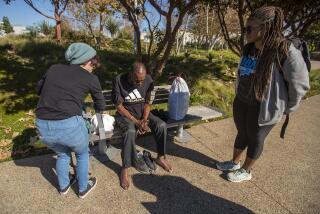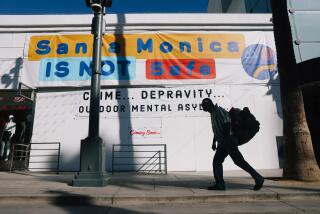Plan for Rose Canyon ‘Tent City’ Raises a Cry : Homeless: San Diego will decide whether to invoke a rarely used law to house thousands now without shelter.
- Share via
SAN DIEGO — First came the news that the San Diego Trolley and a new commuter rail line would come slicing through the canyon. That’s Rose Canyon, near some of San Diego’s most affluent neighborhoods, including the pricey homes of La Jolla Colony.
Now residents here are being informed that the canyon, full of hiking, biking and nature trails, is being considered for a “tent city” for the homeless. The ensuing outcry has given new meaning to the Southern California buzz phrase Not in my back yard .
“Suddenly, Rose Canyon is becoming an embattled area,” said Sandra Boyce, who helped organize a community meeting attended by Councilwoman Valerie Stallings and 200 worried homeowners Wednesday night. “I know it sounds like, ‘Not in my back yard,’ but . . . “
This could affect the entire city--even the state--Boyce said, finishing her thought.
On Oct. 5, the San Diego City Council plans to decide whether to invoke a rarely used state ordinance that would declare a “state of emergency” and allow the city to erect shelter without facing full legal liability.
Officials say 19,000 homeless people wander about San Diego County, more than 7,000 of them in the city of San Diego. Although a specific number hasn’t been decided, thousands of people could take up residence in the canyon.
Stallings, whose district encompasses the Rose Canyon site, near Mission Bay Park and several miles south of the $500,000-plus homes of La Jolla Colony, expects the measure to pass.
Boyce and the legions of outraged homeowners, 300 of whom signed a petition and delivered it to Stallings, not to mention the “hundreds” of people who aides say have phoned her office in a state of panic--expect it to pass, too.
And then, Boyce predicts, “the other shoe will drop,” meaning sites throughout the city proposed as “tent shelters” will, one by one, open their gates to the homeless, forever changing the nature of San Diego.
Nick Johnson, an aide to Councilman John Hartley, believes fomenting opposition to the Rose Canyon site will, on this go-round, force city officials to look elsewhere. A site “ripe for passage,” Johnson said, is an area near Balboa Park. But that site is no stranger to controversy, either.
It would hold as many as 30 large tents, filled with 500 homeless men, women and children, in an abandoned parking lot in front of what used to be San Diego’s naval hospital.
“We would like to see this happen ASAP,” Johnson said, “before the cold weather begins,” meaning Nov. 1.
To do so, the city would need the assistance of a state law--Section 8698 of the California Government Code--that would render the city immune from liability, except for “grossly negligent or reckless or intentional conduct.”
Boyce said invoking the ordinance sets an “ugly” precedent and that the city would be misguided in taking the action.
“The ordinance says a city can declare a crisis when a ‘significant number of people are without the ability to obtain shelter,’ ” she said. “But Hartley has said in interviews that he wants the open-air facility to serve as a facility for the ‘hard-core’ homeless who refuse to avail themselves of other means of shelter.”
Both sides say the Oct. 5 council meeting figures to be, in the words of one combatant, a “doozy.” Mayor Maureen O’Connor, believed to be staunchly opposed to any tent city, recently made a highly publicized stand against them.
A short-lived tent city in Balboa Park was torn down Aug. 26 after the mayor angrily objected to the homeless encampment erected the day before near one of the city’s most popular tourist attractions, the San Diego Zoo.
A dozen San Diego police officers rolled into the squatters’ camp about 7:30 a.m. that day and ordered the tents and homeless off a little-used parking lot that had been converted into a bivouac area--the same lot Hartley wants for a full-time tent city.
“I think the mayor has a problem with geography,” said Johnson, Hartley’s aide. “She and others don’t seem to understand that the parking lot is, technically, not part of the park. A lot of people jump to conclusions before they find out the facts.”
Johnson believes the Rose Canyon defenders are equally misguided. That proposed site may be geographically close to expensive homes and the shimmering waters of Mission Bay, but “in point of fact,” he said, “it’s near a bunch of trash trucks” at a city-owned maintenance yard.
The proposed area is at Balboa Avenue and Morena Boulevard--north of Balboa, west of Morena and east of the Santa Fe railroad right of way that will eventually be used by the trolley and the new rail commuter service, as well as by its existing freight train clients and Amtrak.
“It’s where a bunch of trash trucks are parked!” Johnson said. “God knows how many trash trucks are there already. It’s already a smelly, stinky mess that no one should worry about. But when people hear the term tent city they go crazy. They have visions of millions and millions of unwashed homeless just lingering around--near their neighborhoods.”
Bob Glaser, spokesman for the Save Rose Canyon Committee, said the proposed tent city poses a greater threat to the Clairemont and Bay Ho neighborhoods than it does to La Jolla Colony, whose residents forced the Metropolitan Transit Development Board to think of trolley routes other than those along Genesee Avenue or Regents Road, which would have cut through the heart of the canyon.
But residents throughout the area are feeling “increasingly put-upon,” Glaser said.
“For these and a lot of other reasons, we feel the canyon is becoming a battleground,” he said. “Where Gilman Drive touches Interstate 5, there was a project, already under way, that fell apart in bankruptcy. They had started preliminary grading and were building retaining walls and so forth when they up and quit!
“Now it’s all washing down into roadways and becoming a serious public nuisance, with dirt and gravel all over the place,” Glaser said. “It isn’t a good time to be talking about tent cities.”
John Moody, who lives in nearby Villa Morena, said that “plenty of other good sites,” including “plenty of enclosed buildings,” exist elsewhere in the city.
Originally, the Wednesday night meeting was planned for Moody’s home, but the high turnout sent the crowd outdoors to a neighbor’s patio.
At the meeting, the residents peppered Stallings with comments and questions about the proposal:
“How come we never knew Rose Canyon was being considered?”
“This is a very expensive proposition for us. . . . The economic impact involves millions of lost dollars in property value.”
“There are rabbits you can displace. . . . These people should not be in our neighborhoods.”
“What are we going to do when they begin using the canyon as a public restroom?”
Perhaps the comment that received the most enthusiastic response was spoken by Bay Ho resident Karen Jarrett, a staff manager at a local hospital: “The more you make it good for these people to come to San Diego, the more will come.”
Moody said he’s also troubled by the city’s effort to use a “dubious” state ordinance to “make sure it’s not liable for disasters after all the health and safety standards have been lowered.”
He said he’s also strongly opposed, as are most of his colleagues and Councilwoman Stallings, to the proposal of a “self-governing” tent city, run by and for the homeless, who would use the area as a large, outdoor way station.
“The concerns we have are the ones you might imagine--about alcohol, drugs, crime. . . . We don’t believe the homeless are capable of running these facilities themselves, and to compound the problem by the city not accepting responsibility just sounds real ominous to us,” Moody said.
Part of the problem, Stallings says, is that increasing hordes of homeless men, women and children are infiltrating not just Balboa Park and downtown San Diego, but also the city’s beach areas and even parts of exclusive La Jolla.
“A (City Council committee) proposed several possible sites in (Stallings’) District 6, and when I looked at them, well, the only site that seemed even remotely feasible was Rose Canyon,” Stallings said.
At the community meeting, she said, “I will not be an advocate for that site.”
The underlying problem, said Frank Landerville, project director for the city’s Regional Task Force on the Homeless, is that, as the nation’s sixth-largest city continues its population explosion, “pressure points” involving the homeless multiply as fast as growth figures.
“We now have so many more homeless than emergency shelters,” Landerville said. “We have more and more people who need places to stay--tonight--but places aren’t available. And, as the city grows, the problem will only get worse.”
More to Read
Sign up for Essential California
The most important California stories and recommendations in your inbox every morning.
You may occasionally receive promotional content from the Los Angeles Times.










